April 2009 Coffee News
-Another Honduras-Minnesota Connection
Another Honduras - Minnesota Connection
We are so fortunate this month to be able to share with you an article and some photos from author and poet Joyce Sidman (www.joycesidman.com) who just returned from a trip to Rio Negro where her son is working in the Peace Corp (and where the Velasquez Coffee farm is).
Joyce generously wrote the following article about their trip especially for our newsletter.
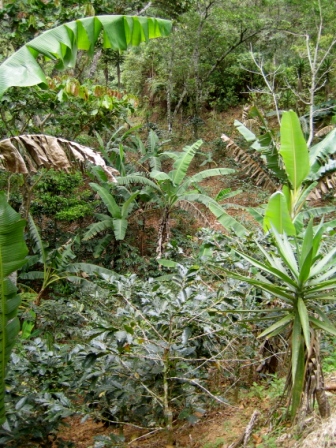
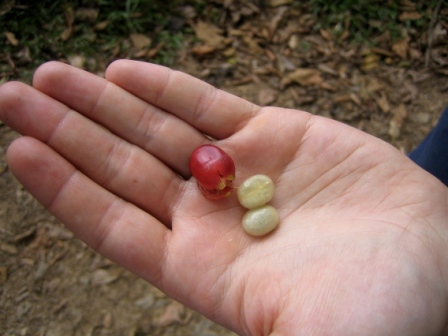 "When our son Gabe went off to Honduras with the Peace Corps, we never expected to discover a local Twin Cities connection to the remote village where he lives. When Gabe told us excitedly that the Velasquez family of Rio Negro had relatives in St. Paul, we immediately made contact. Meeting Cathy and Guillermo Velasquez, and drinking their delicious coffee—grown in the mountains Gabe hikes everyday—has made us feel much closer to him. Gabe is a Protected Areas Management volunteer, working in Rio Negro to help coffee farmers receive organic designation for their beans (thus earning more money). He is also helping develop ecotourism in the village.
"When our son Gabe went off to Honduras with the Peace Corps, we never expected to discover a local Twin Cities connection to the remote village where he lives. When Gabe told us excitedly that the Velasquez family of Rio Negro had relatives in St. Paul, we immediately made contact. Meeting Cathy and Guillermo Velasquez, and drinking their delicious coffee—grown in the mountains Gabe hikes everyday—has made us feel much closer to him. Gabe is a Protected Areas Management volunteer, working in Rio Negro to help coffee farmers receive organic designation for their beans (thus earning more money). He is also helping develop ecotourism in the village.
Last week we had the incredible experience of traveling to Honduras to visit Rio Negro. It was an arduous but rewarding journey, up a long, rutted dirt road that leaves the crowded, dusty town behind and enters a magical, lush cloud forest. Almond and banana trees tower overhead, and green, glossy coffee plants flourish beneath them on the steep hillsides, carefully planted and tended.
It was a special thrill for me, a lifelong coffee drinker, to see how this plant grows. The main harvest was over, but we saw a few coffee berries (about the size of cranberries) still clinging to the trees, and popped one open to find the twin coffee beans, white and somewhat slimy.
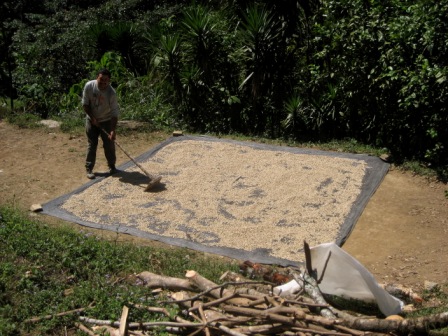

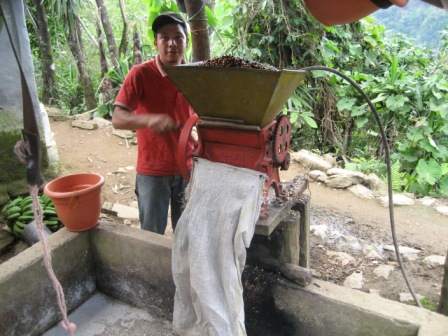
Gabe’s host dad, Lucío Yanez, explained the process of milling (to remove the beans from the fruit), washing, drying, and hulling the beans. It is labor intensive work, but Lucío and other hardworking shade-grown coffee farmers have been able to make a good living for themselves and their families, as well as develop good land stewardship practices. We saw lots of birds and insects—including toucanets eating ripe figs and leafcutter ants marching along with bits of leaves—that are thriving amongst the coffee plants.
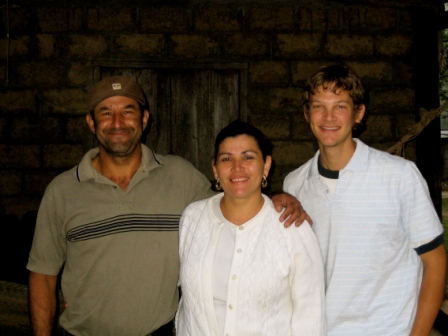 We ate several delicious meals with Guillermo’s brother and sister-in-law, Avilio and Bertilia Velasquez. What dynamic, engaging people! They are clearly at the forefront of innovation in this progressive village, and we listened, fascinated (with Gabe translating) as Avilio told us the history of coffee farming in Rio Negro. It was an honor, too, to meet Don Maximo and Doña Natalia, two of the founders of the village and the heads of the Velasquez clan.
We ate several delicious meals with Guillermo’s brother and sister-in-law, Avilio and Bertilia Velasquez. What dynamic, engaging people! They are clearly at the forefront of innovation in this progressive village, and we listened, fascinated (with Gabe translating) as Avilio told us the history of coffee farming in Rio Negro. It was an honor, too, to meet Don Maximo and Doña Natalia, two of the founders of the village and the heads of the Velasquez clan.
Rio Negro is a special place, and we’ll always be grateful that we were able to make the trip to see it. Life is not easy for those who live there, but with hard work and far-sighted planning, they are able to harvest what one local guide called the 'jewels of the forest.'" -- Joyce Sidman





